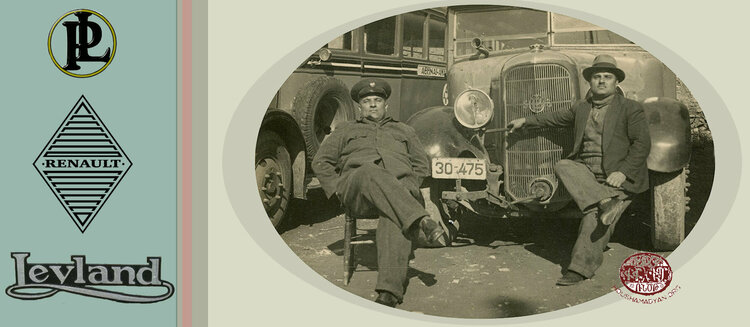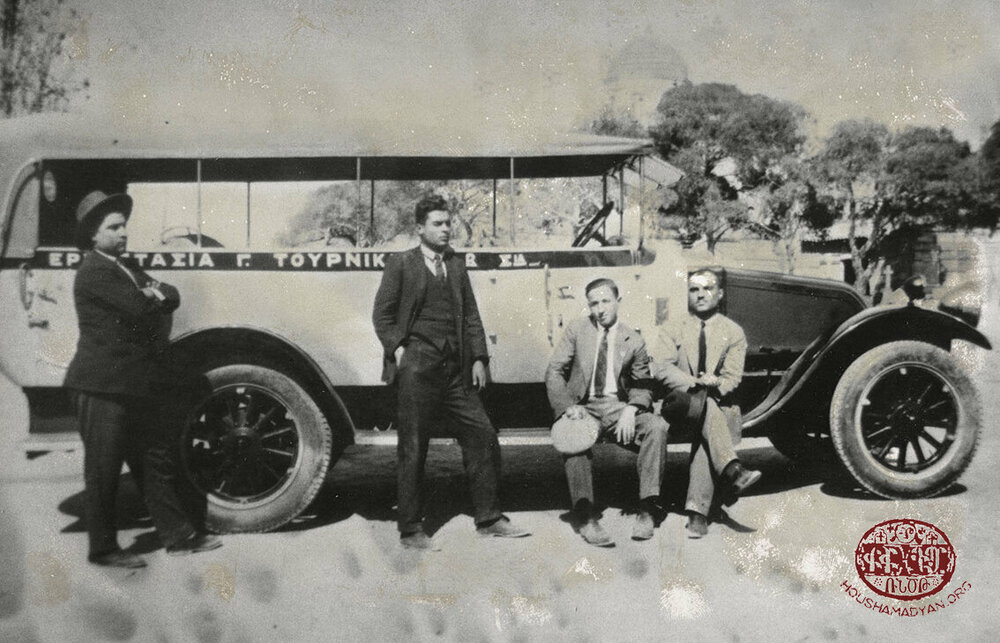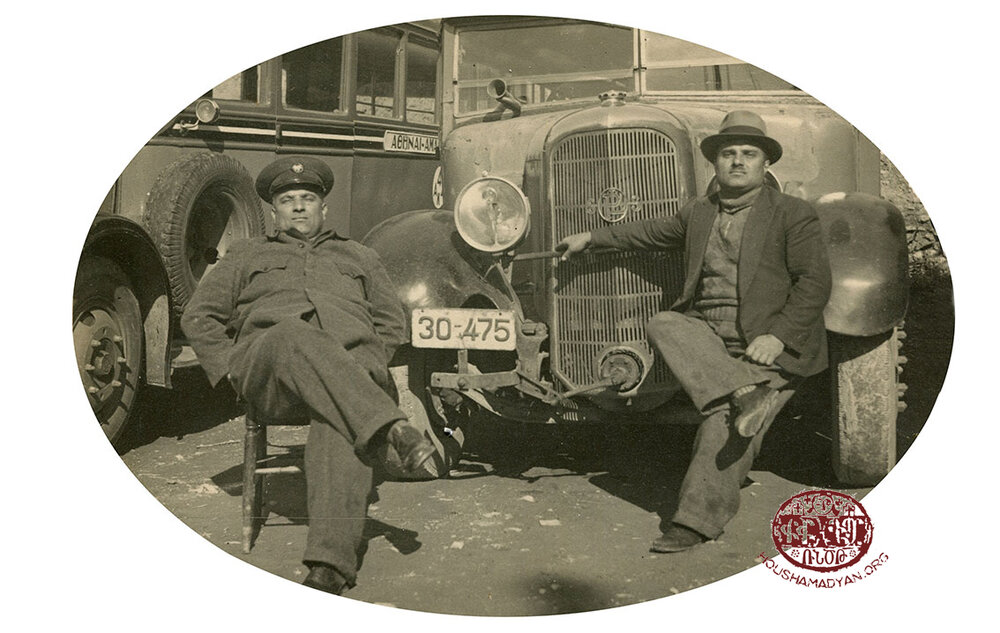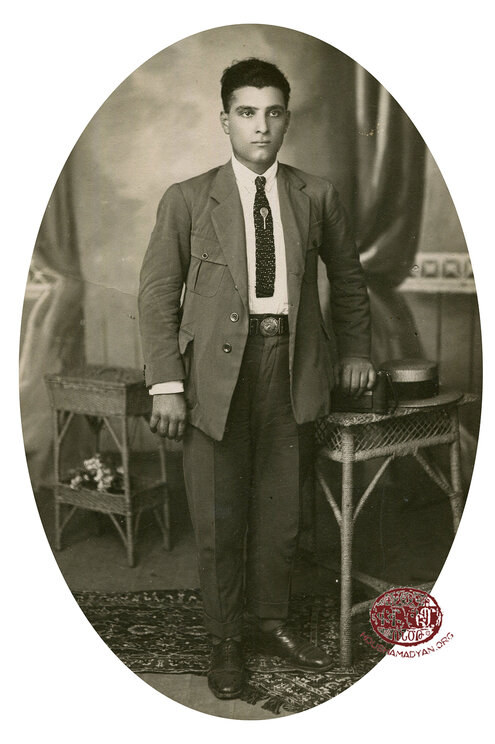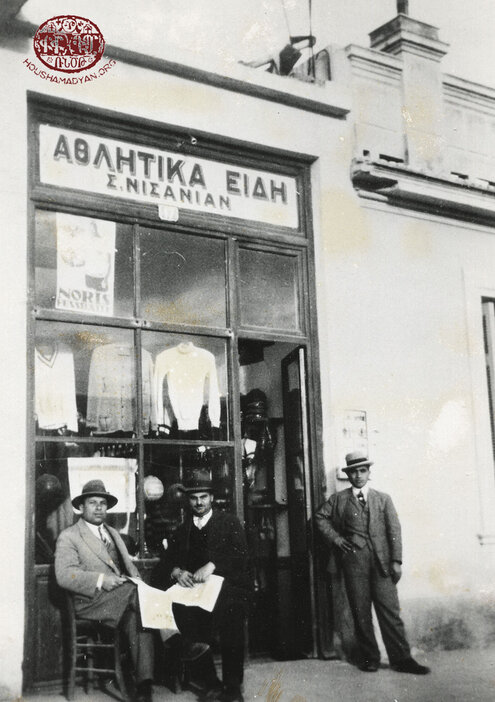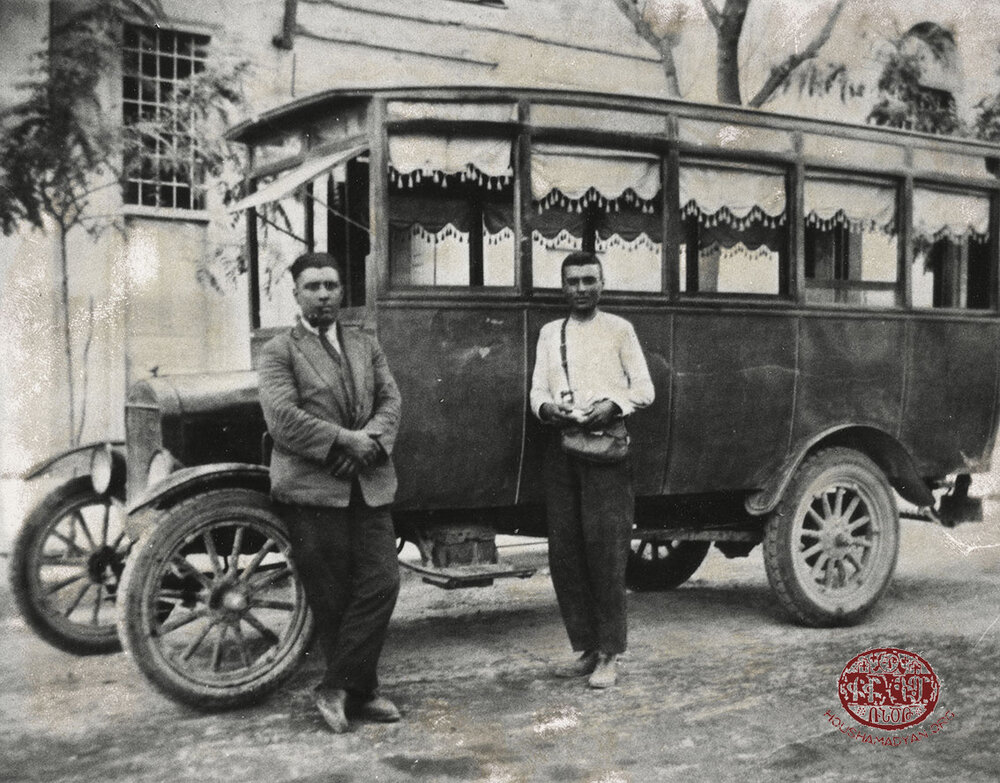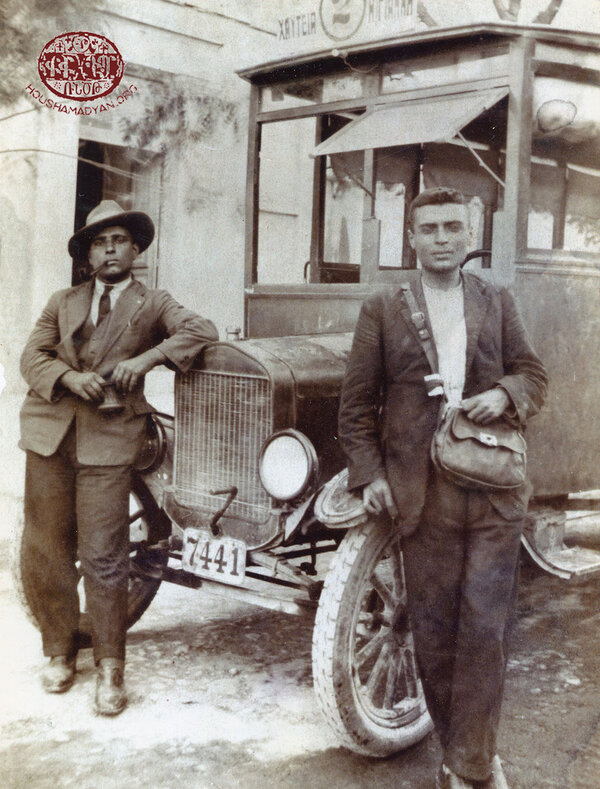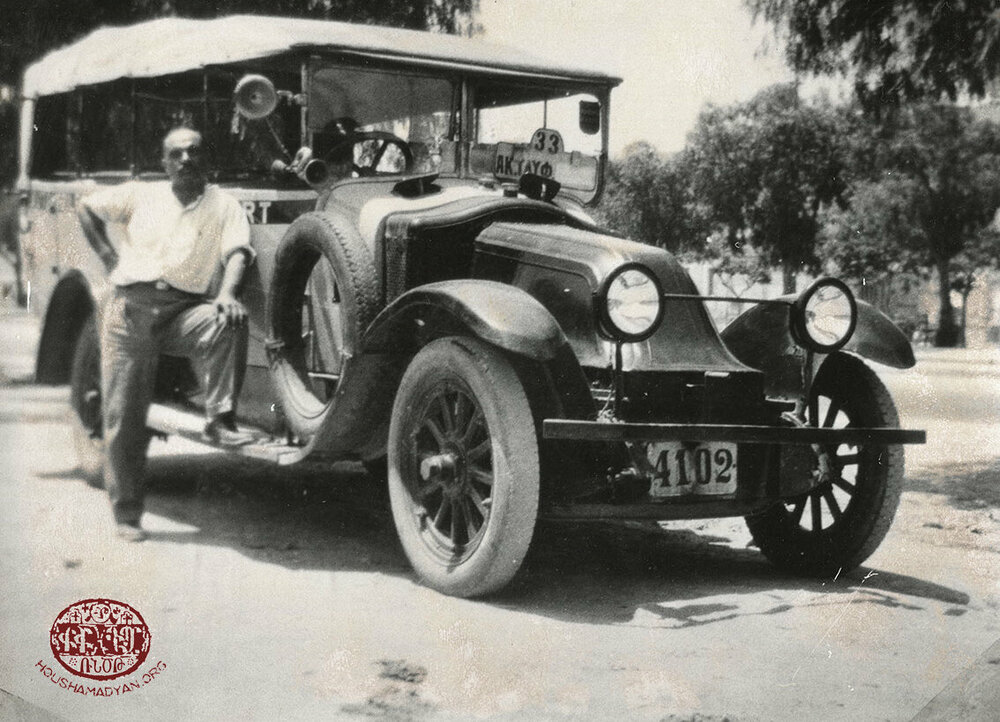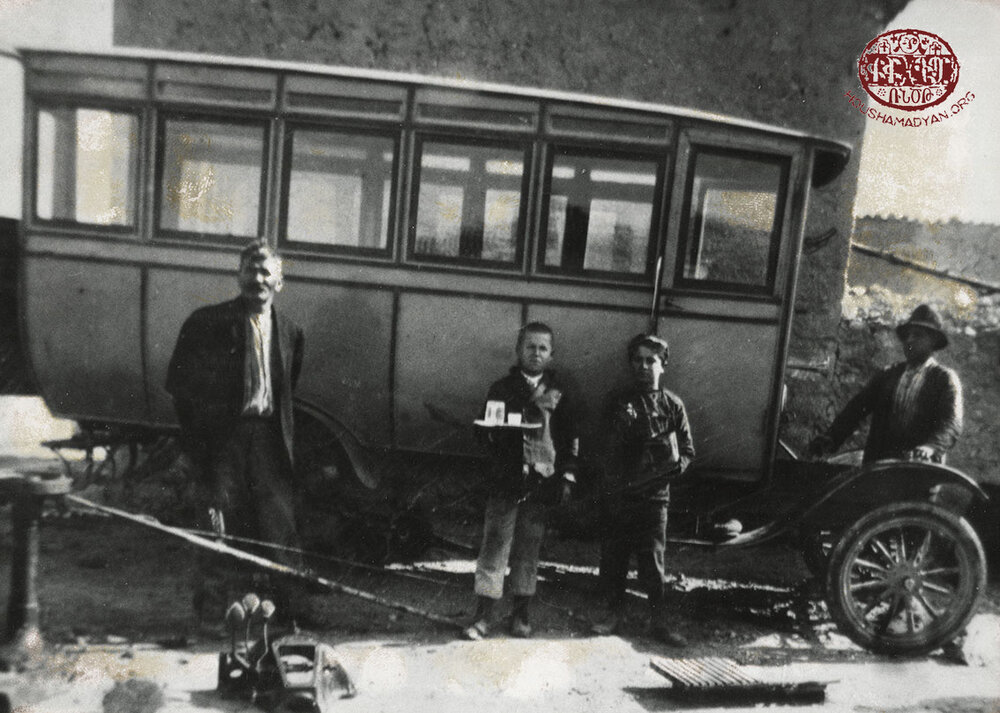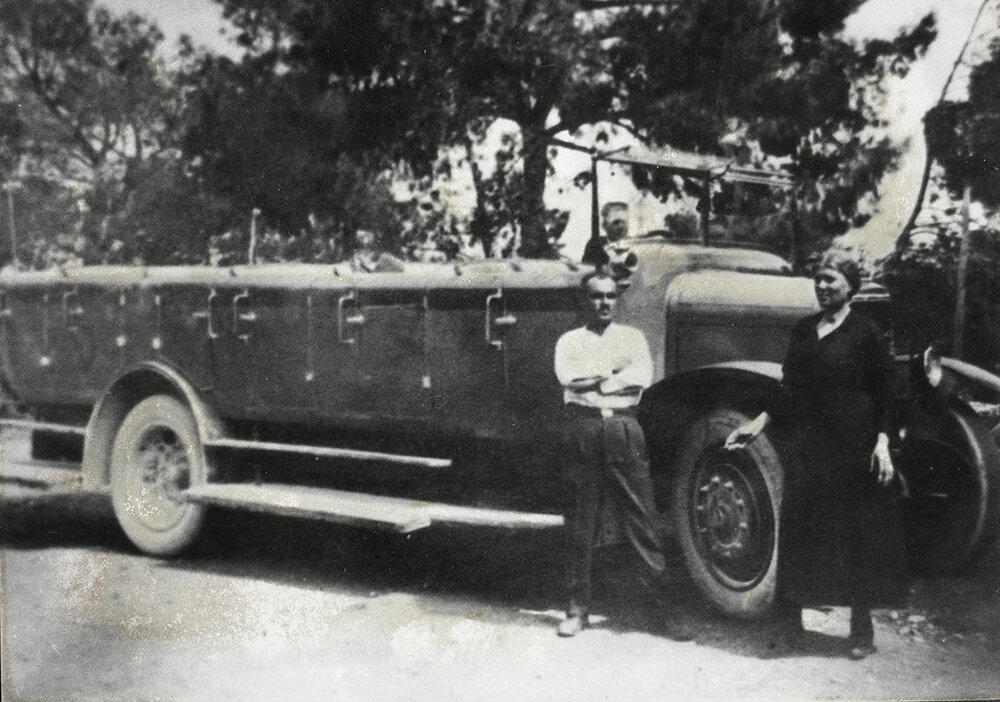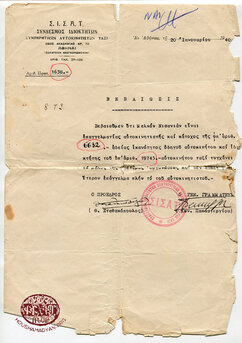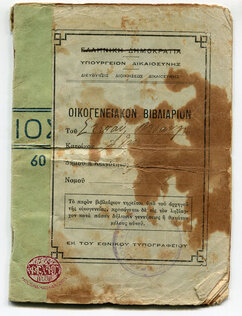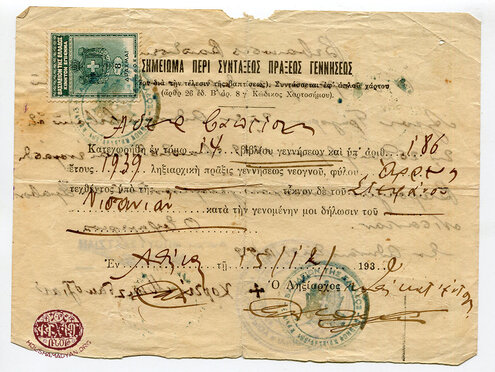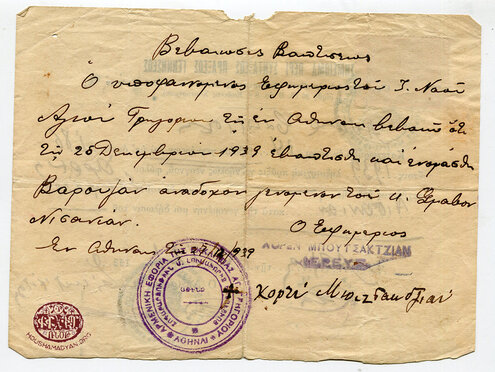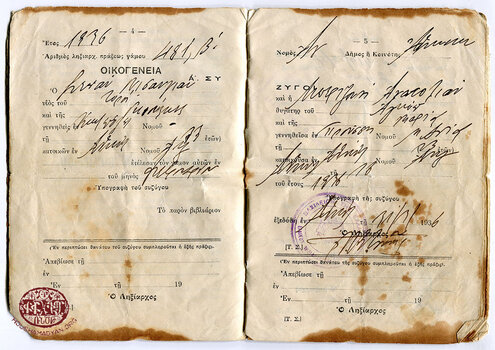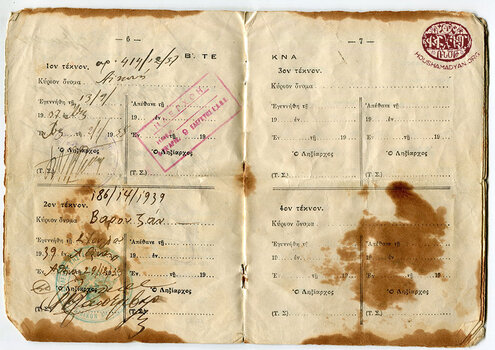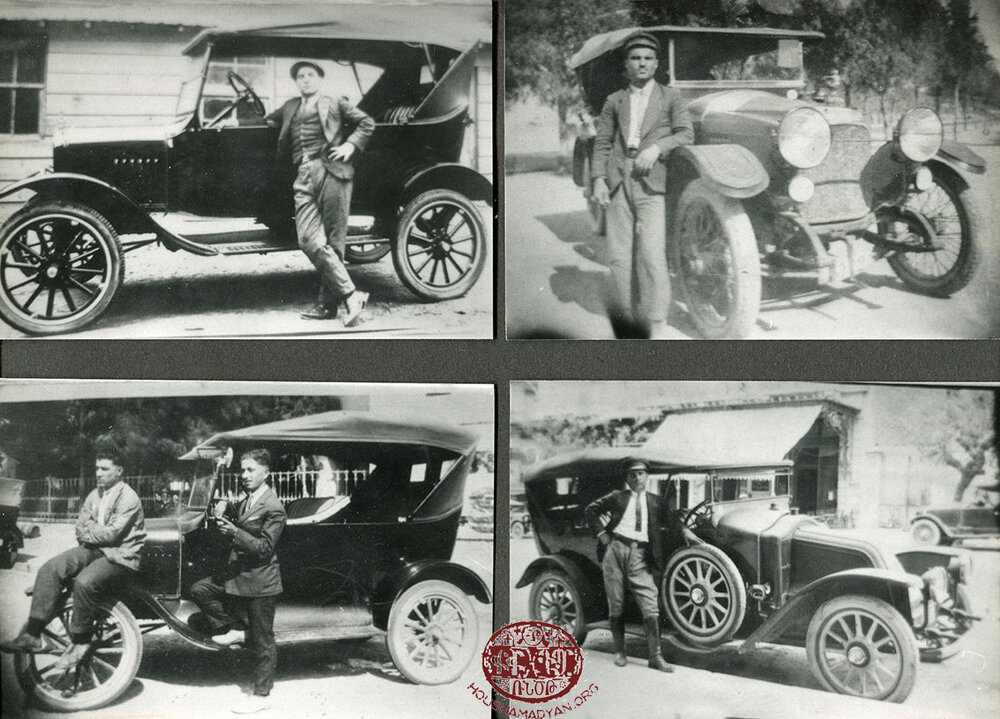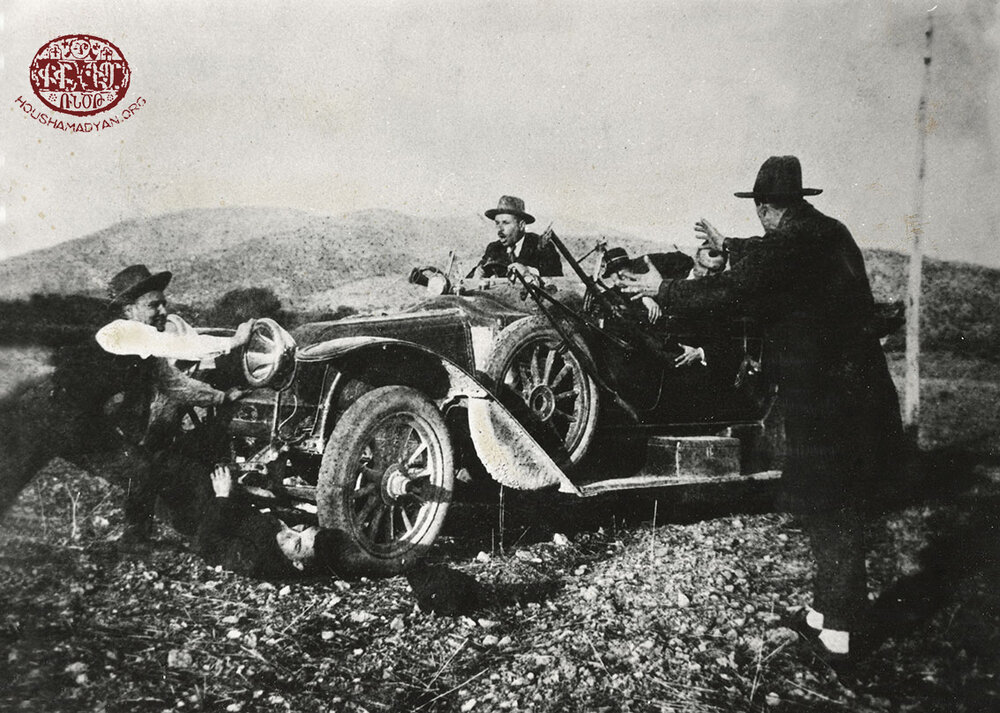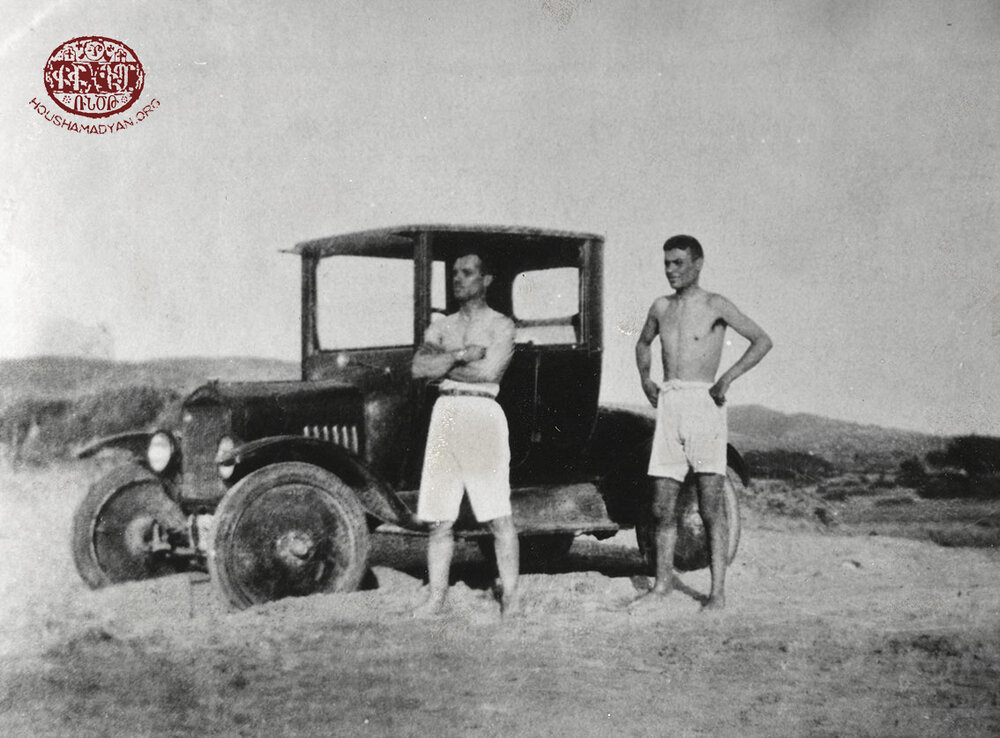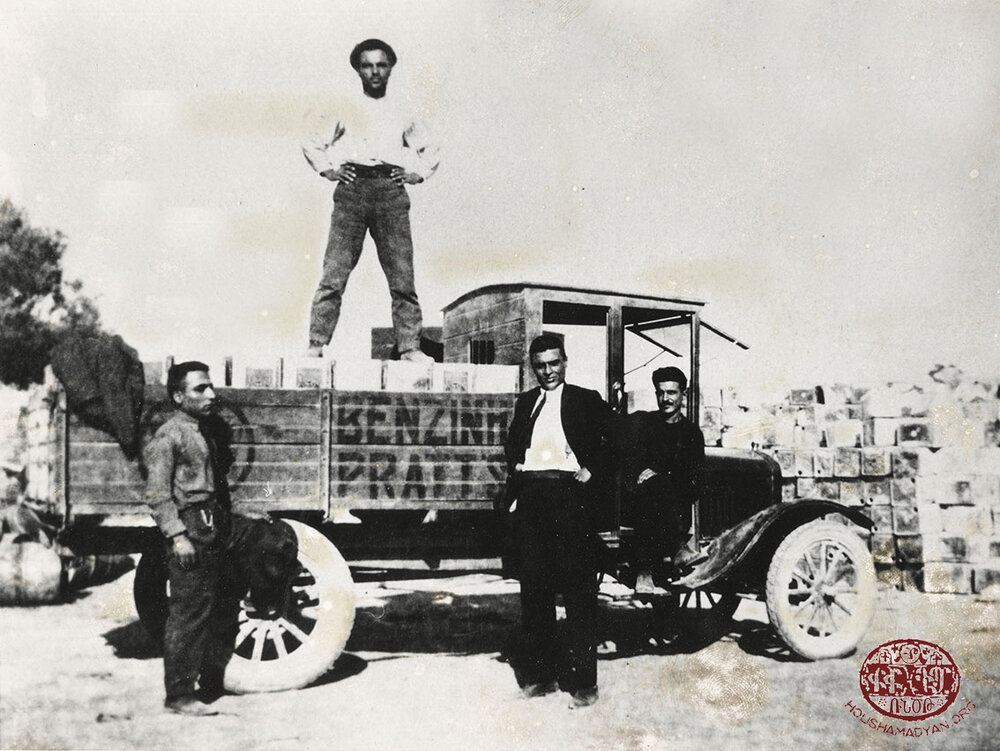Varoujan Nisanian/Nshanian – Athens
Author: Ani Apigian, 15/12/2022 (Last modified: 15/12/2022) - Translator: Simon Beugekian
The history of the Nshanian family was presented to us by Varoujan Nshanian during the Houshamadyan workshop in Athens, in April 2022. As our readers will see, the main character of the family’s history is Sdepan, Varoujan’s father, who ran his own bus company in Athens. Most of the photographs presented on this page feature Sdepan and the vehicles that he owned.
Varoujan’s grandfather, Toros Nshanian, hailed from Constantinople; while his grandmother, Haygouhi Gulbengian, was born in Kayseri/Gesaria.
Haygouhi and Toros met and fell in love in Constantinople. Toros was a building painter. The Gulbengian family opposed the couple’s marriage, but eventually, Haygouhi was able to impose her will on her parents.
Toros and Haygouhi had four sons: Hagop, Shmavon, Melkon, and Sdepan. Sdepan was Varoujan Nshanian’s father. Haygouhi and Toros also had a daughter who died during birth.
Sdepan Nshanian was born in 1901, in Constantinople. He attended an English college (name unknown) and was one of the first scouts of the Armenian General Benevolent Union (AGBU) scouting program in the city. Sdepan and his family lived in the Pera (Beyoğlu) neighborhood of Constantinople. After the First World War, when British forces occupied the city, Sdepan attended the military academy founded by the British, where he learned how to drive and repair cars. Thereafter, he and his brother, Melkon, were employed as drivers for high-ranking British military officers.
At the time, or to be more precise, in July 1921, Misak Torlakian assassinated Behbud Khan Javanshir, the former Minister of the Interior of Azerbaijan, who was chiefly responsible for the anti-Armenian pogroms that took place in Baku in 1918. Torlakian was arrested by the British military authorities and tried. Throughout the trial, Torlakian was transported from jail to court by Sdepan and Melkon. They were also responsible for chauffeuring Kapriel Varjabedian, who was employed as a translator during the trial, and was also a high-ranking officer in the British forces. Eventually, Torlakian was released from detention and exiled to Greece. Later, when Varjabedian also moved to Greece, he served as the secretary of the Greek chapter of the AGBU and the deputy president of the National Committee.
In 1923, Sdepan also settled down in Greece, in the city of Thessaloniki. He began working as a driver for the Danish Consulate. This was deemed to be equivalent to serving in the Greek military. At the time, a committee formed by the League of Nations was operating in the city, supervising the process of population transfer between Greece and Turkey. This committee, which consisted of 11 members, included a Danish diplomat who worked for the Danish Consulate in Thessaloniki. The consulate decided to dispatch Sdepan to Paris, so that he could purchase a better car to be used by this Danish diplomat. Sdepan purchased a Renault, which he drove to the port of Marseille, and from there, shipped it by sea to Thessaloniki. After using the vehicle for several years, the consulate gifted it to Sdepan.
In 1925, Sdepan moved to and settled down in Athens. In those years, vehicles were a rare sight in the streets of the Greek capital. He found employment in the Greek royal palace, where the staff were amazed by Sdepan’s car. A special garage was provided to house the vehicle in the palace stables.
Sdepan had to meet two requirements to be able to work at the palace. First, he had to serve in the Greek forces, and second, he had to obtain Greek citizenship. The first condition was fulfilled when Sdepan enlisted with the city’s fire brigade. Seemingly, this was a nominal position, as Sdepan continued working at the royal palace throughout this time. Then, again with the intervention of the palace, Sdepan obtained Greek citizenship, which was a rare phenomenon among Armenians living in Greece in the 1920s and 1930s.
Around 1925, Sdepan was able to move his mother, Haygouhi, and his brother, Melkon, from Istanbul to Athens. He and his brother became inseparable, sharing the close bonds of brotherly love until their deaths. Varoujan stated that the two brothers were married on the same day. Their other brother, Hagop, moved to Argentina from Istanbul with his family.
Sdepan’s third brother, Shmavon, also migrated to Athens alongside his wife, Anoush Gudenian. They did not stay in Greece for very long, and proceeded to various European countries, then to Moscow, and then finally to Soviet Armenia, where they settled down in Yerevan. However, they did not stay there for very long, either. Dissatisfied with the living conditions in Armenia, they swam across the Aras River and found shelter in neighboring Iran. Anoush and Shmavon had received higher education and knew several languages. As a result, the Iranian authorities expressed interest in their situation. But they soon left Iran, too. They took a ship to Cyprus, and then made their way back to Greece, where they settled down permanently. Anoush and Shmavon had one son, Garo Nshanian. In Athens, Shmavon began working for the bus company owned by his brother Sdepan.
In 1936, Sdepan married Berdjouhi. She was born in Bursa, where her family was engaged in sericulture. Berdjouhi’s father, Hagop Anadolian, had imported modern sericulture equipment to Constantinople from Europe, and produced modern, high-quality silk that he exported to European countries. Hagop’s factory was located to the east of Bursa, in the city of Bilecik. Hagop was probably killed during the years of the Genocide when he was pushed off a speeding train. Years later, when Sdepan and Berdjouhi visited Istanbul, they traveled to Bursa and Biledjik, where they were able to locate the ruins of Hagop Anadolian’s factory.
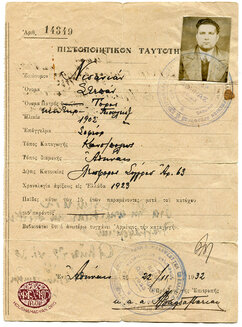
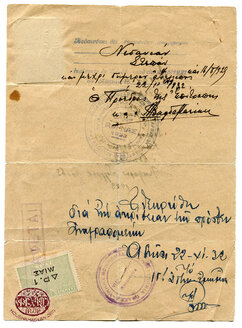
After Hagop’s death, Berdjouhi and her two brothers, Artin and Hagopdjan, as well as their mother, Mariam, migrated to Greece. First, they lived in the city of Pyrgos, in the province of Elis, then settled down in Athens. During the years of the Second World War, when Greece was under Nazi occupation and the country faced hunger and economic hardship, Artin and Hagopdjan, like many other locals, would venture out of the city to find kindling. The German forces often confused these foragers for partisans and summarily executed them. One day, Artin and Hagopjan headed for the area of Stavros Agias Paraskevis (on the road from Marathon to Athens) to collect kindling. Spotting a squad of German soldiers in the distance, they dropped the wood they had collected and fled. Hagopdjan was able and make his escape, while Artin hid in a barrel full of water. He, too, was able to escape the Germans on this occasion, but due to his lengthy immersion in water, he contracted tuberculosis, was taken to a hospital, and died shortly thereafter. Later, Hagopdjan began working for his brother’s bus company.
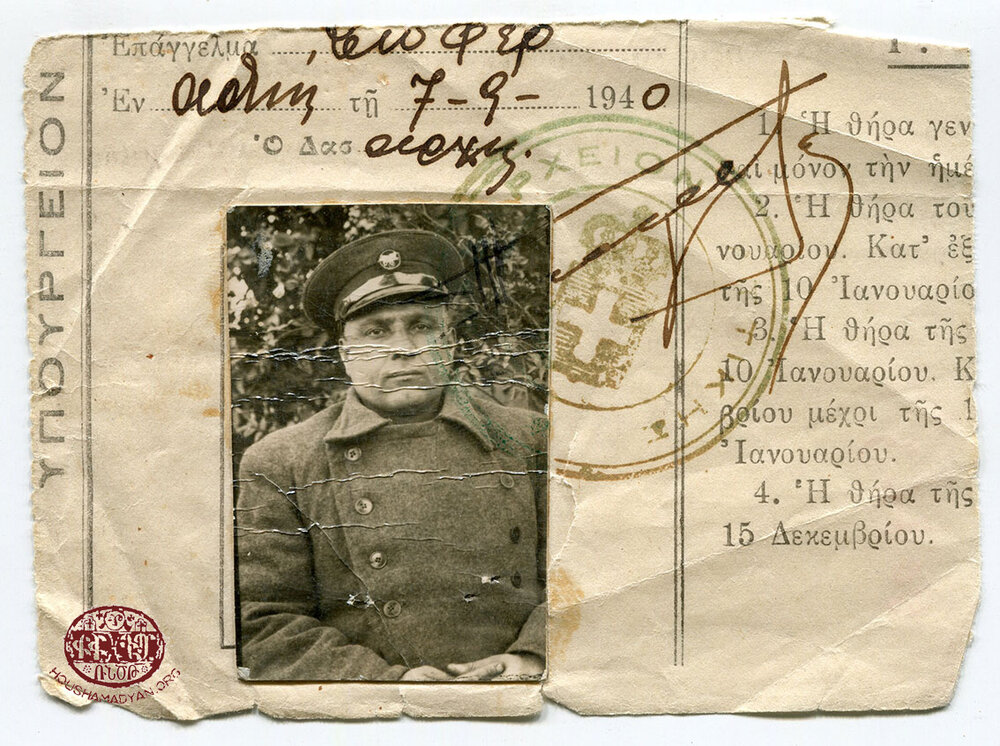
In Athens, Sdepan worked in the field of bus transportation. The first vehicle he used was the Renault he had brought from Paris. It was a passenger vehicle, but Sdepan had modified it and converted it into a bus. By the end of the 1920s, he already owned eight buses and founded his own transportation company. During these years, he traveled to France once again to buy buses and ship them to Greece. Sdepan also bought the old buses of the Greek royal palace, repaired them, and added them to his company’s fleet.
With these vehicles, Sdepan would take Armenian workers from Athens to Laurium, which was home to numerous mines that employed Armenian migrants. Sdepan would also transport wood to the refugee camp of Durguti, a neighborhood of the Greek capital, so that the local Armenians could build homes. It was in this refugee camp that Sdepan met his wife, Berdjouhi, whom he married in 1936. Their daughter, Hripsime, was born in 1937; and their son, Varoujan, was born in 1939.
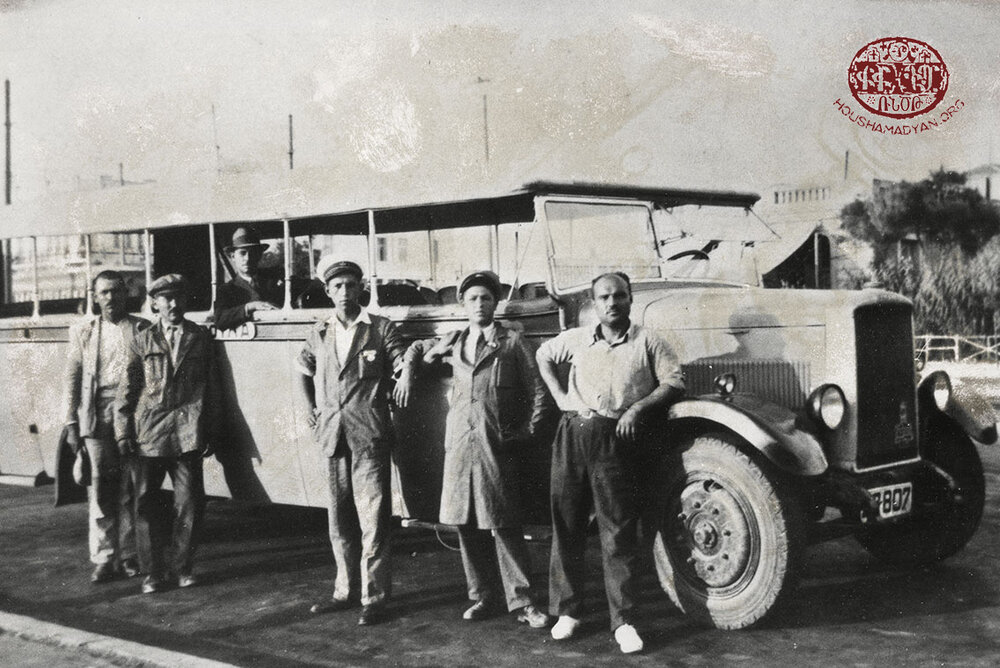
In the late 1920s, due to the international financial crisis, various Greek transportation companies went bankrupt and closed their doors. Sdepan’s company, too, ceased operating. He kept his buses in a garage in the Koukaki neighborhood of Athens, and in 1932, he opened a store in the city selling athletic gear. A few years later, he shuttered this store and reactivated his bus company.
During the Second World War, when Italian Fascist forces attacked Greece via Albania (in 1940), Sdepan was called up to the Greek army. This marked the beginning of his third official stint serving in the Greek military. He was sent to the Albanian front to fight. The family still remembers that when Sdepan came back home, he was physically exhausted, especially as the Greek forces had marched on foot. The family also remembers that his clothes were flea-ridden.
Early during these years of war, Greek forces, and later the Nazi occupation forces, requisitioned civilian buses to use them for military purposes. Some of Sdepan’s buses were among the vehicles that were requisitioned. Varoujan remembers that the German forces selected and requisitioned only the German-made vehicles that Sdepan owned.
